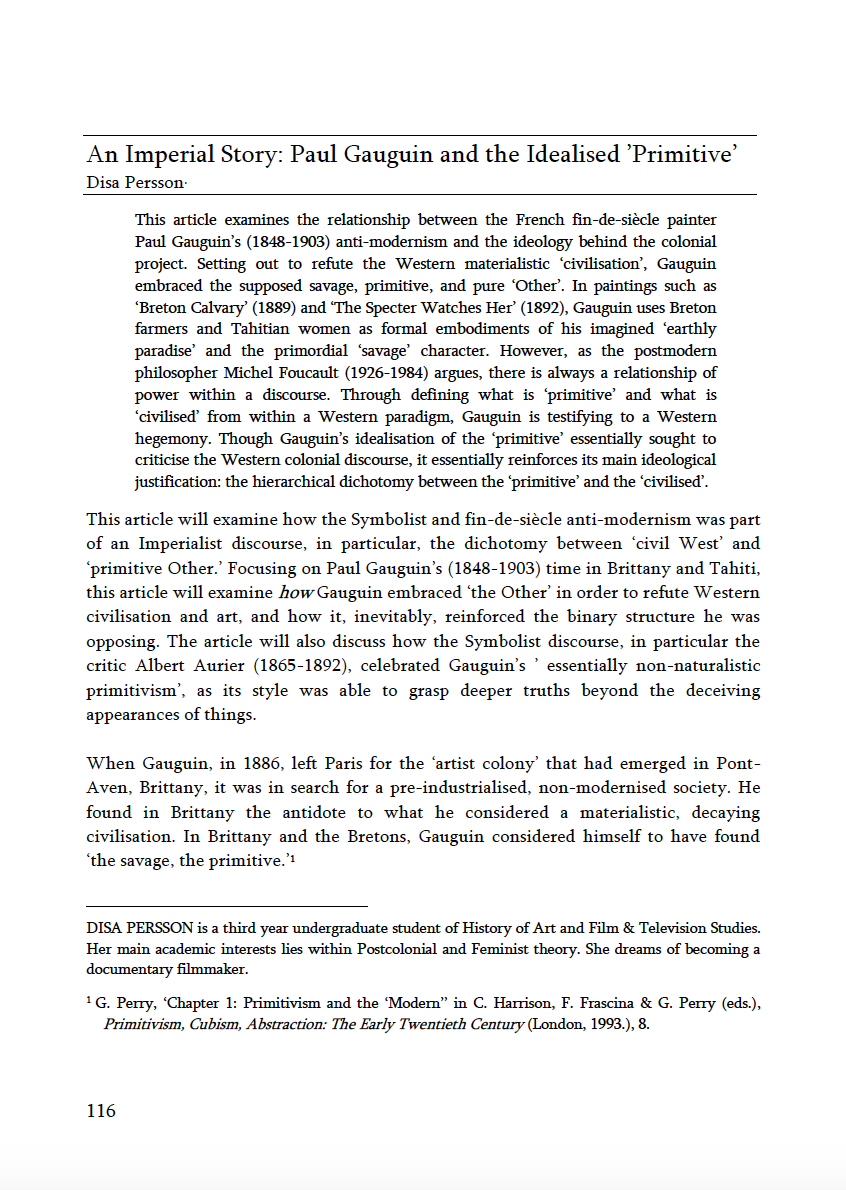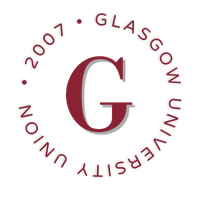An Imperial Story
Paul Gauguin and the Idealised ‘Primitive’
DOI:
https://doi.org/10.36399/GroundingsUG.8.212Keywords:
Gauguin, Colonialism, Primitive, Anti-modernism, Savage, Primordial, Western Colonialism, DiscourseAbstract
This article examines the relationship between the French fin-de-siècle painter Paul Gauguin’s (1848-1903) anti-modernism and the ideology behind the colonial project. Setting out to refute the Western materialistic ‘civilisation’, Gauguin embraced the supposed savage, primitive, and pure ‘Other’. In paintings such as ‘Breton Calvary’ (1889) and ‘The Specter Watches Her’ (1892), Gauguin uses Breton farmers and Tahitian women as formal embodiments of his imagined ‘earthly paradise’ and the primordial ‘savage’ character. However, as the postmodern philosopher Michel Foucault (1926-1984) argues, there is always a relationship of power within a discourse. Through defining what is ‘primitive’ and what is ‘civilised’ from within a Western paradigm, Gauguin is testifying to a Western hegemony. Though Gauguin’s idealisation of the ‘primitive’ essentially sought to criticise the Western colonial discourse, it essentially reinforces its main ideological justification: the hierarchical dichotomy between the ‘primitive’ and the ‘civilised’.
References
A. G. Aurier, ‘Symbolism in Painting’ in C. Harrison, P. Wood & J. Gaiger (eds.), Art in Theory: 1815-1900: an anthology of changing ideas (Oxford, 2007).
P. Dagen, ‘Gauguin’s Politics’ in B. Thomson (ed.), Gauguin: Maker of the Myth (London, 2010).
H. Dorra, The Symbolism of Paul Gauguin: erotica, exotica and the great dilemmas of humanity (Berkeley, 2007).
V. Gille, ‘The Last Orientalist: Portrait of the Artist as Mohican’ in B. Thomson (ed.), Gauguin: Maker of the Myth (London, 2010).
L. Goddard. ‘Following the Moon: Gauguin’s Writing and Myth of the ‘Primitive’’ in B. Thomson (ed.), Gauguin: Maker of the Myth (London, 2010).
E. H. Gombrich, The Preference for the Primitive (London, 2002).
V. Jirat-Wasiutynski, Paul Gauguin in the context of Symbolism (New York, 1978).
J. F. Knapp, ‘Primitivism and Empire: John Synge and Paul Gauguin’ (1989) 41:1 Comparative Literature 53-68.
N. Lübbren, Rural artists’ colonies in Europe: 1870-1910 (Manchester, 2001).
L. Nochlin, ‘Symbolism and the Dialectics of Retreat’ in S. F. Eisenman (ed.), Nineteenth Century Art: A Critical History, 3rd Edition (London, 2007).
G. Perry, ‘Chapter 1: Primitivism and the ‘Modern’’ in C. Harrison, F. Frascina & G. Perry (eds.), Primitivism, Cubism, Abstraction: The Early Twentieth Century (London, 1993).
J. Simpson, ‘Symbolist Aesthetics and the Decorative Image/Text’ (2000) 25:2 French Forum 177-204.
J. F. Staszak, ‘Primitivism and the other: History of art and cultural geography’ (2004) 60:4 GeoJournal 353-364.
P. ten-Doesschate Chu, Nineteenth-Century European Art, 2nd Edition (New Jersey, 2006).
B. Thomson, ‘Landscape and Rural Narrative’ in B. Thomson (ed.), Gauguin: Maker of the Myth (London, 2010).

Downloads
Published
Issue
Section
License
Copyright (c) 2015 Disa Persson

This work is licensed under a Creative Commons Attribution 4.0 International License.
The CC BY 4.0 license is a Creative Commons license. This is a non-copyleft free license that is good for art and entertainment works, and educational works. It is compatible with all versions of the GNU GPL; however, like all CC licenses, it should not be used on software. People are free to: Share — copy and redistribute the material in any medium or format; Adapt — remix, transform, and build upon the material for any purpose, even commercially. The licensor cannot revoke these freedoms as long as you follow the license terms. But they must conform to the following terms: Attribution — You must give appropriate credit, provide a link to the license, and indicate if changes were made. You may do so in any reasonable manner, but not in any way that suggests the licensor endorses you or your use. No additional restrictions — You may not apply legal terms or technological measures that legally restrict others from doing anything the license permits.
Please check individual article PDF copies to see if any additional restrictions apply.







